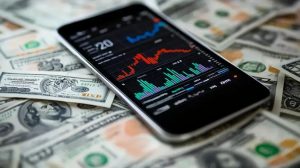Best Budgeting Apps USA 2025 are revolutionizing how we manage finances, offering tools that make tracking expenses and setting goals easier than ever. With so many options available, it’s crucial to find the one that aligns with your financial priorities and lifestyle.
These apps not only help you stay on top of your spending but also encourage better financial habits with features like reminders and progress tracking. Whether you’re saving for a vacation or aiming to pay off debt, the right app can make a significant difference.
The good news is that choosing the best one doesn’t have to be overwhelming. Keep reading to explore the top features and apps that will help you manage your money efficiently in 2025.
Top Features of Budgeting Apps
One of the top features of budgeting apps is their ability to track spending. These apps automatically categorize your expenses, helping you see where your money goes each month. This clear overview allows you to make informed decisions about your spending habits.
Another essential feature is the goal-setting function. Many budgeting apps let you set financial goals, such as saving for a vacation or paying off debt. By showing you progress towards these goals, they motivate you to stick to your budget and reach your targets faster.
Lastly, budgeting apps often offer reminders and alerts. These notifications can alert you when bills are due or when you’re close to exceeding your budget limits. Such features help you stay on track and avoid unwanted fees, making money management much easier.
Comparison of Leading Budgeting Apps
When comparing leading budgeting apps, it’s important to consider their features, ease of use, and pricing. Apps like Mint and YNAB (You Need a Budget) are popular choices.
Mint is free and offers easy expense tracking, while YNAB requires a subscription but provides unique budgeting methods to help manage money effectively.
Another noteworthy app is EveryDollar, which simplifies budgeting by allowing users to create customized plans. It has a free version, but the paid version includes added features like bank syncing.
Personal Capital stands out for its investment tracking, making it ideal for users who want to oversee both their budget and investments in one place.
Each app has its own strengths and weaknesses. While some may offer better tracking and goal-setting capabilities, others excel in investment management.
It’s essential to assess what features matter most to you before choosing the perfect budgeting app for your financial journey in 2025.
How to Choose the Right Budgeting App

Choosing the right budgeting app starts with understanding your personal financial goals. Ask yourself what you want to achieve. Are you looking to save more, track your expenses, or plan for future investments? By knowing your goals, you can pick an app that fits your needs.
Next, consider the features that are most important to you. Some apps focus on expense tracking, while others emphasize goal setting or investment oversight.
Take the time to review the features of several apps. Look for user-friendly interfaces and additional tools, such as savings calculators or debt trackers, that can enhance your budgeting experience.
Finally, think about the cost. Many budgeting apps offer free versions, but some might charge a monthly or yearly fee for premium features.
Read reviews and compare these costs against the benefits you receive. The right budgeting app should not only help you control expenses and maximize savings, but it should also fit your budget.
User Reviews and Ratings of Budgeting Apps
User reviews and ratings play a crucial role in determining the effectiveness of budgeting apps. Many users highlight their experiences with various features, such as ease of use and the ability to track expenses.
For example, people often praise apps like YNAB for their budgeting methods that encourage proactive financial management, while others appreciate Mint for its straightforward setup and expense tracking capabilities.
However, it is also common to see mixed reviews. Some users report frustration with glitches or limitations in free versions.
Apps like Personal Capital receive high marks for investment tracking but may not satisfy those seeking simple budget management. These diverse opinions can help you weigh the pros and cons before selecting an app.
Finally, star ratings can reveal a lot about user satisfaction. Apps with higher ratings generally indicate that most users find them helpful.
Reading a mix of positive and negative reviews can provide insights into what you can expect. Overall, user reviews are valuable resources when exploring the best budgeting apps in 2025.
Future Trends in Budgeting Apps
Future trends in budgeting apps indicate a shift toward greater personalization. Users will likely see more apps offering tailored recommendations based on their financial habits and goals.
This could include personalized budget plans that adapt as users input their spending data. With artificial intelligence and machine learning at play, budgeting apps will become smarter and more intuitive.
Another trend is the integration of budgeting apps with other financial tools. As technology advances, users can expect seamless connections between their budgeting apps, bank accounts, and investment platforms.
This integration will allow users to view their complete financial picture all in one place, simplifying the decision-making process.
Lastly, an increased focus on security features will be essential. As more people turn to digital solutions for managing their finances, budgeting apps will enhance security measures, such as two-factor authentication and encryption, to protect user data.
This focus on security will help build trust and confidence among users, making budgeting apps an even more essential part of personal finance management.
Choosing the right budgeting app involves evaluating your specific financial needs and lifestyle. Every person has different priorities, whether it’s tracking daily expenses, planning for a vacation, or saving for retirement.
By identifying what you want to achieve, you can narrow down your choices to apps that will help you meet those goals effectively.
Another important factor is the user interface and experience. An app that is easy to navigate and visually appealing can make budgeting less of a chore.
Look for features that simplify budget creation and visualization, such as colorful charts and simple tracking options that keep your attention while helping you stay organized.
Lastly, consider the type of customer support offered by the app. In case of any questions or issues, responsive support can make a big difference.
Read reviews to see what other users say about the app’s support services. A budgeting app that provides excellent customer service can enhance your overall experience and ensure you get the most out of its features.




